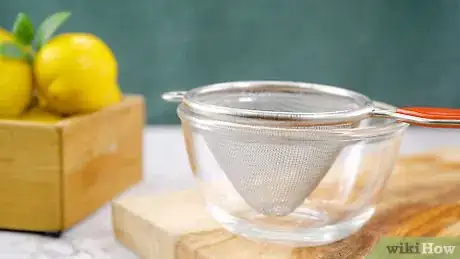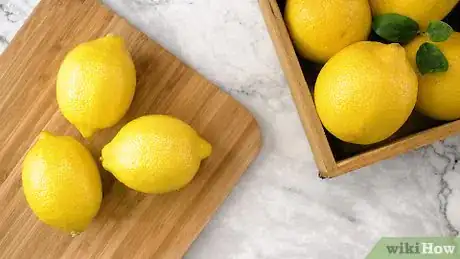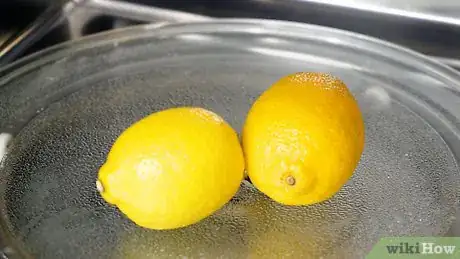wikiHow is a “wiki,” similar to Wikipedia, which means that many of our articles are co-written by multiple authors. To create this article, 17 people, some anonymous, worked to edit and improve it over time.
There are 9 references cited in this article, which can be found at the bottom of the page.
The wikiHow Video Team also followed the article's instructions and verified that they work.
This article has been viewed 66,264 times.
Learn more...
You might want to juice a lemon for many reasons, whether you want to make some sour lemonade or for any other foods. Juicing the first lemon is fun. Juicing the second lemon is easy. Juicing the eighth lemon may leave you doubting whether lemonade is worth the effort. Learn how to save yourself the frustration and get the most juice out of each lemon, and forget your citrus worries once again.
Steps
Ways to Juice a Lemon
-
1Cut the lemon lengthwise. Cut the lemon in half, from tip to tip. This makes a more flexible lemon peel, easier to squeeze.[1]
- If you have a hinge-style hand juicer cut them crosswise instead for a better fit.
-
2Place a mesh strainer over a bowl. The mesh will catch the lemon seeds and pulp, letting the juice drain through.Advertisement
-
3Squeeze with a pair of tongs. Place a lemon half between the two arms of your kitchen tongs, near the prongs, and squeeze. This is fast, easy, and doesn't fill your kitchen drawer with a one-purpose tool.
-
4Scrape it out with a fork or spoon. This alternative requires even less specialized equipment. Hold the lemon half firmly with one hand, angling the lemon downward to avoid a squirt of juice in your face. Stick a fork or spoon in the pulp and rotate it around the lemon. Repeat until very little pulp remains.
- A fork will let you scrape out the last bits of pulp, getting more juice from each lemon. But if you're juicing a whole pile of lemons, pick the spoon for a faster job.
- If you only want a few drops of lemon juice to flavor a dish, just stick the fork in a whole lemon and squeeze. The rest of the lemon will stay good for much longer than a cut half.[2]
-
5Use a manual juicer. These cheap tools speed up the job a little and are a bit less messy. Find one made from wood, plastic, or enameled aluminum, since the bare metal will gradually corrode if exposed to citric acid. They come in three varieties:
- A hand juicer sits over your bowl, with a ridged knob sticking up. Press the lemon half down and rotate several times around the knob. Squeeze to the edge of the skin to get all the juice.
- A reamer has an identical knob, attached to a handle instead. Hold the lemon half in one hand and rotate the reamer around the lemon.
- A hinged squeezer is the fastest, but only when juicing lemons that fit nicely into your model. Cut off the knobby tip if present, then place your lemon half face-down in the cup. Hold over the bowl and press the other arm hard against the lemon, turning it inside out.[3]
-
6Buy an electric citrus juicer for large quantities. An all-purpose juicer will put a great deal of bitter pith in your juice, and its metal blades may corrode over time. Buy a specialized citrus juicer for better results.
- If using an all-purpose juicer, peel the lemon first or wash it thoroughly to remove trace pesticides.
- Many experts agree that hand-squeezed juice tastes better, possibly because an electric machine scrapes away too much pith, or fails to break out flavorful oils from the peel.
Maximizing Juice and Speed
-
1Pick juicy lemons. Smaller lemons have a higher percentage of juice, so select these if buying lemons by weight or juicing a large number. Avoid rough-skinned lemons, which may have shriveled and lost juice as they aged.[4]
- When shopping, heft two similarly-sized lemons, one in each hand. The heavier one has more juice.
- Meyer is the most common extra-juicy variety, but some areas will stock Fino, Primofiori, or Lapithkiotiki from the Mediterranean. Varieties low in juice include Femminello, Interdonato, and Verna.[5]
-
2Store lemons in the freezer. When plants freeze, their water expands into ice crystals and ruptures the cell walls. Once thawed in the microwave or a 15-minute cold water bath, all that water trapped inside those cells will be ready to add to your juice.[6]
- Wash and dry the lemons before freezing in an airtight container. Fresh lemons will retain quality for at least four weeks in the freezer.
-
3Microwave the lemons before cutting. A warm lemon is easier to squeeze, and some say it even produces more juice. Zap the lemons for 10–20 seconds, or a few seconds more if frozen, until soft and slightly warm to the touch. This weakens the material that holds the juice, and causes the juice to flow more easily.[7]
- This works especially well on older lemons or lemon varieties with thick skins.[8]
- If the fruit is steaming, you've gone too far and boiled away some of the juice.
Things You'll Need
One of the following:
- Fork
- Spoon
- Kitchen tongs
- Hand juicer
- Reamer
Warnings
- Once you've peeled or zested a lemon, the fruit will dry out much faster.[13] Squeeze immediately after peeling, refrigerate the juice, and use within a few days for best flavor.⧼thumbs_response⧽
References
- ↑ http://www.thekitchn.com/does-cutting-a-lemon-lengthwise-really-give-you-more-juice-putting-tips-to-the-test-in-the-kitchn-199946
- ↑ http://www.cooksinfo.com/lemons
- ↑ http://drinks.seriouseats.com/2011/08/cocktail-101-how-to-juice-citrus-best-tools-for-juicing-limes-lemons.html
- ↑ http://www.cooksinfo.com/lemons
- ↑ http://www.frutas-hortalizas.com/Fruits/Types-varieties-Lemon.html
- ↑ http://whatscookingamerica.net/lemons.htm
- ↑ http://drinks.seriouseats.com/2013/07/cocktail-science-using-citrus-smarter-techniques-for-better-lemon-lime-flavor-drinks-acidity-twists-citrus-peel-oils.html
- ↑ http://forums.egullet.org/topic/138777-microwaving-lemons-and-limes-before-squeezing/
- ↑ http://www.cookingissues.com/2010/10/01/fresh-lime-juice-wtf/
- ↑ http://drinks.seriouseats.com/2013/07/cocktail-science-using-citrus-smarter-techniques-for-better-lemon-lime-flavor-drinks-acidity-twists-citrus-peel-oils.html
- ↑ http://drinks.seriouseats.com/2013/07/cocktail-science-using-citrus-smarter-techniques-for-better-lemon-lime-flavor-drinks-acidity-twists-citrus-peel-oils.html
- ↑ http://www.gardeningknowhow.com/edible/fruits/citrus/citrus-fruit-thick-rind.htm
- ↑ http://drinks.seriouseats.com/2013/07/cocktail-science-using-citrus-smarter-techniques-for-better-lemon-lime-flavor-drinks-acidity-twists-citrus-peel-oils.html
About This Article
To easily juice a lemon, microwave it for 10-20 seconds beforehand so it's easier to squeeze the juice out. Then, cut the lemon in half lengthwise with a knife. To prevent the pulp and seeds from falling into your lemon juice, place a mesh strainer over the bowl or glass you're going to use. When you're ready, squeeze the lemon over the mesh strainer using a pair of tongs. You can also use a spoon or fork to scoop the pulp and juice out. If you don't have any utensils, just use your hands to squeeze the lemon. If you want to learn how to use a manual juicer on your lemons, keep reading the article!






















































